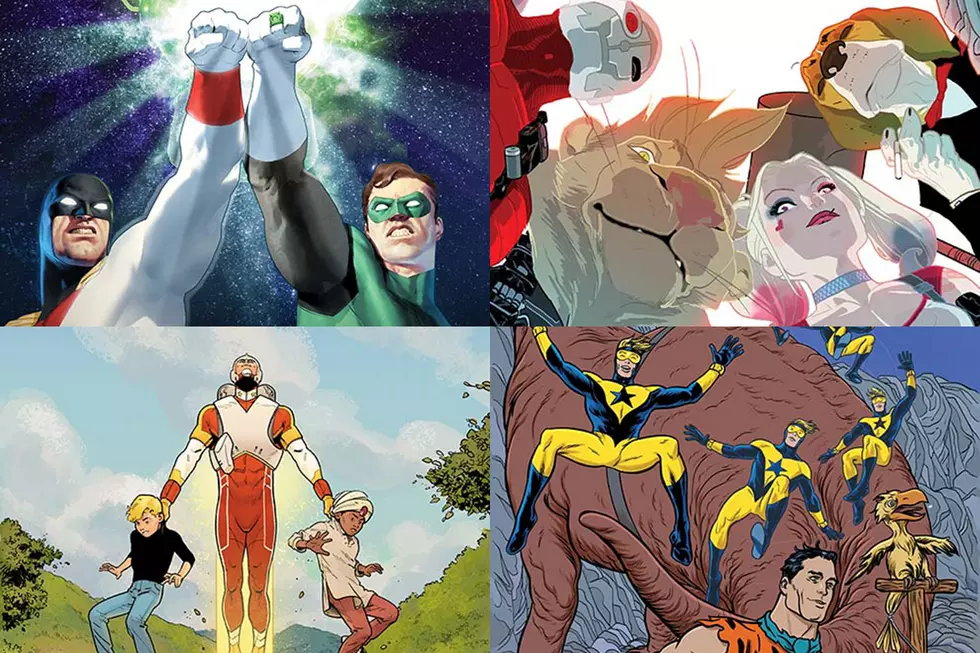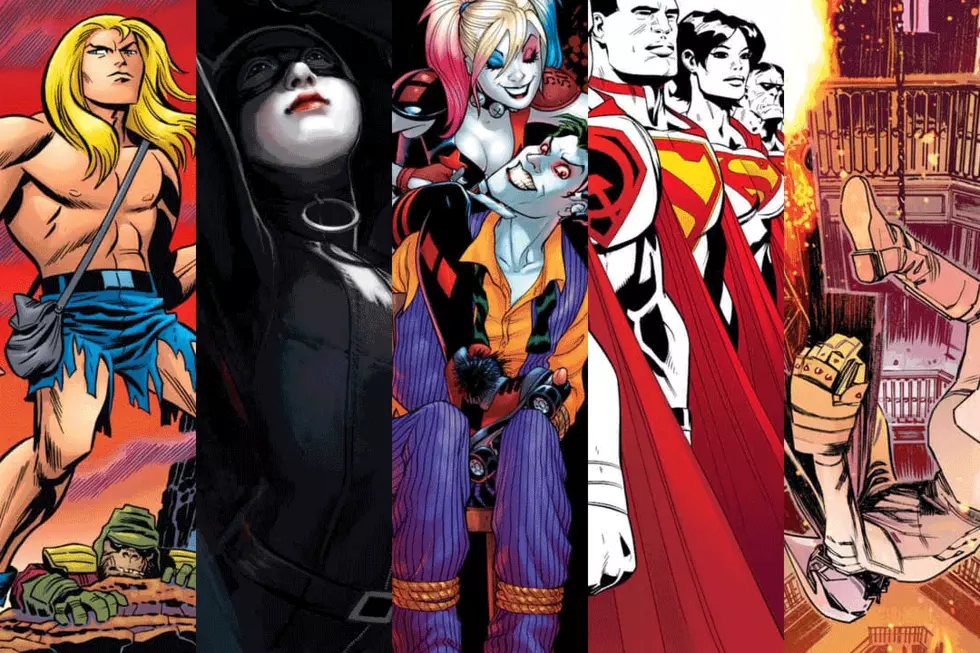
Answering Dan DiDio: The Problem With Having Only 1% Female Creators at DC Comics
 Last Thursday at Comic-Con International, during the first of four New 52 panels held by DC Comics to discuss their line-wide relaunch of superhero titles this September, a fan walked up to the microphone and posed a question to Co-Publisher Dan DiDio about the demographics of the New 52 creators:
Last Thursday at Comic-Con International, during the first of four New 52 panels held by DC Comics to discuss their line-wide relaunch of superhero titles this September, a fan walked up to the microphone and posed a question to Co-Publisher Dan DiDio about the demographics of the New 52 creators:
"Why did you go from 12% in women [creators] to 1% on your creative teams?"
To which DiDio replied in a startlingly aggressive tone, "What do those numbers mean to you? What do they mean to you? Who should we be hiring? Tell me right now. Who should we be hiring right now? Tell me." [audio via Robot6]
It seems like a bit much to demand that the fan asking the question be the one to answer the question -- since it's more DiDio's job to know that answer than some random guy at Comic-Con -- but more interesting is what is implicit in DiDio's question: the idea that there either aren't any female creators out there equipped to step into these creative roles, or that he's aware of the talented female creators out there but for whatever reason can't find a place for them in the DC Universe.Granted, a big part of this is doubtless the complicated shared universe qualities of DC comics and how aspects of its house artistic style are more limiting than the world of indie comics. As artist Rebekah Isaacs explains in an essay where she also says that she has always felt very welcomed as a creator at DC:
If you want to work in mainstream comics, style matters. I've reviewed hundreds of portfolios and I've been surprised to meet many women who draw in a very manga-influenced, storybook, or cartoon style, but have ambitions of breaking into Marvel and DC. Marvel and DC have to run a business around a franchise of instantly-recognizable characters, so it makes sense that they mostly hire artists who draw in a "superhero" style for consistency. It's possible to change your style -- I did quite a lot in college -- but there's nothing more heartbreaking than seeing an artist change they unique personal vision just to try to get a job. If you find yourself having to do this to get closer to a "house style", then you might want to reconsider how passionate you'd really be about the job if you did get it.
I suspect this is a lot of what keeps many female creators away -- not, as Isaacs agrees, some vast conspiracy to bar women from the comic book treehouse -- but as Marvel's Girl Comics initiative proved last year, there are a lot of talented women in the field capable of bringing something new to the table. And while their names may not be on the tip of the tongue for people accustomed to the Big Two's regular stable of creators and their work may be a bit outside the typical aesthetics, isn't that exactly the type of bold chance DC Comics should be taking in an enormous venture like the New 52?
The relaunch aims to reach out to a new and significantly broader audience that has no inherent attachment to the typical superhero illustration style and -- in my own experience with new readers -- is just as easily confused by it as interested in it. So why is there any reason to believe that DC's house style will be more accessible to the mainstream than something more cartoony or manga-influenced, particularly since those are the versions of superheroes the mainstream public has seen on TV for the last twenty years in animated television shows and movies?

It's also worth noting that Isaacs, like several other female creators including Kelly Sue Deconnick and Marjorie Liu, have spoken publicly about being approached by DC for work, so it can't be said that DC isn't making any effort at all. But regardless, if the number two publisher in comics really is reaching out and is still having that much difficulty attracting and holding on to female creators, it would seem to point to just as much of a problem.
All that aside, I'd like to talk for a moment about my answer to DiDio's question, which is what those statistics mean, because I think it's an important one. Including different types of people on a staff of creative people who are building a world together isn't important just because it makes for more PR-friendly staff photographs, but because these are the people entrusted with the god-like power of controlling the actions of these characters, putting words in their mouths, dressing them, representing their experiences in the world, not to mention showing the audience how to look at them and telling what they should value about them.
Whether you're a racial minority, or a woman, or someone with something other than straight sexuality, or someone with a physical disability to name only a few examples, you're going to have a different experience of the world. It can be hard to know exactly what that's like if it isn't you -- the slights and the everyday indignities that you don't see because that's what privilege means: It means you don't have to deal with them. Often, it means you don't even have to notice that they exist.
 This also means that you can be a very well-intentioned person and still end up saying and doing -- or writing and drawing -- accidentally demeaning things simply because you just don't understand. And if you're a creator and you're trying to write and draw characters that are different from you, it can mean that you end up sounding inauthentic, tone-deaf, or worse, actively feeding into stereotypes.
This also means that you can be a very well-intentioned person and still end up saying and doing -- or writing and drawing -- accidentally demeaning things simply because you just don't understand. And if you're a creator and you're trying to write and draw characters that are different from you, it can mean that you end up sounding inauthentic, tone-deaf, or worse, actively feeding into stereotypes.
A lot of claims of sexism and racism get thrown around in comics from time to time, but I'm firmly of the opinion that many of them -- such as the unfortunate map naming Flashpoint's African continent as "ape-controlled" -- didn't come from any sort of prejudice, but simply from this sort of lack of awareness.
So how do you fix this, when you're a well-intentioned person who absolutely had no idea something would be cringe-worthy or even hurtful? The first suggestion, made by CA writer David Brothers after the ape-controlled incident:
Get a black friend. Male or female, it doesn't matter, just get one. We're easy to find. Get one and then ask him if it's cool to have Africa ruled by a monkey. Just run it by them, real casual-like. "Hey man, what do you think about this?" If they give you the gasface or their eyebrows narrow... change your plans.
None of this is to say, of course, that a white male creator can't write a black man or a woman or a transgendered person or anyone else different from them with authenticity. And of course, you can't necessarily go checking in with a minority friend every single time you plan to open your mouth (or write and draw a script, if you're a creator), not least of all because it would probably be really annoying to your friend.
But creators who really care -- not just about avoiding PR disasters, but about representing characters in a way that is more real and more powerful -- deal with this by trying to create an understanding that goes beyond fact-checking. They talk to the people around them who have insight into the experiences those characters would deal with, and they listen. And more importantly, they keep listening.
While these individual efforts to better understand and represent the human condition are pretty essential both on a creative and socially responsible level, if you have a staff whose makeup is totally disproportionate to its characters, this kind of imbalance is going to have consequences, both in subtle terms of aesthetics and characterization, and more dramatic terms of straight up exploitation and stereotyping. It's worth saying again: Women are half of the world, and a significant percentage of the DC Comics character stable, and yet only 1% of their creators.
And the way that you treat and represent half of the people in your world -- and by extension, half of the people in the real world who might potentially buy your books -- should be more than a marginal concern. And not to put too fine a point on it, but that seems like something that perhaps deserves some more careful and nuanced attention when a comic book cover like this is pretty much par for the course:

Like I said, there have been a lot of criticisms of racism and sexism in comics, some valid and some not, but in my opinion, almost all of the incidents have come from a place of ignorance and not malice. Nonetheless, at a certain point when these complaints become chronic enough -- and especially when you're attempting to undertake a massive creative reboot designed to bring in a wide variety of new readers -- saying you just didn't realize isn't going to cut it anymore.
It's one thing to make mistakes, and it's another thing to make no effort to learn from them. And it's a whole other thing on top of that to significantly reduce the kind of diversity that gives you some hope of preventing those mistakes in the future, rather than making it a priority to have the people who write these comics reflect the diversity of their pages.
To answer Dan DiDio's question: There are many, many very talented women working in the industry who could infuse something very valuable into DC Comics, at a time when they probably need it the most. As a female fan, I desperately wish he would consider their aesthetics and contributions to the industry as viable options for the superhero books I want to read so badly but feel so chronically alienated by, something that honestly breaks my heart on a regular basis. And regardless of where that question is coming from -- whether he genuinely doesn't know who they are or genuinely couldn't figure out a way to fit them into the DC Universe -- I couldn't help but find the fact that he had to ask it very sad.
More From ComicsAlliance
![An Epic Adventure Is Underway In ‘The Kamandi Challenge’ #1 [Preview]](http://townsquare.media/site/622/files/2016/12/KACHA_Featured.jpg?w=980&q=75)



![Everything We Can’t Wait To See At San Diego Comic Con, Part Two: Saturday & Sunday [SDCC 2016]](http://townsquare.media/site/622/files/2016/07/SDCC-Sat1.jpg?w=980&q=75)




